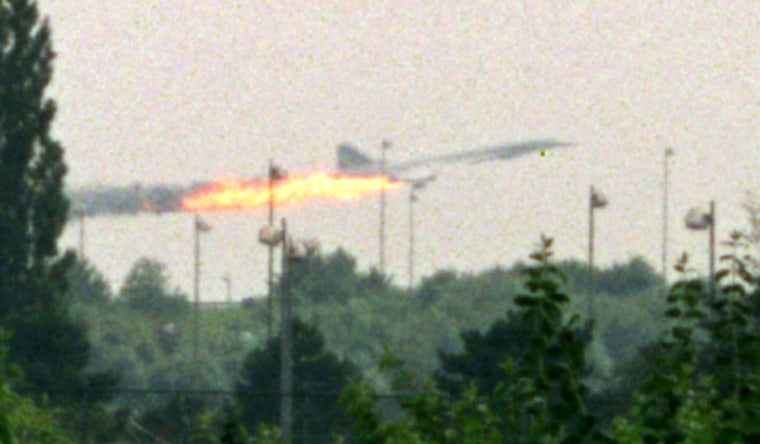French prosecutors summoned Continental Airlines Inc.’s top two executives for questioning in the investigation of the July 2000 crash of a supersonic Air France Concorde, two lawyers said Tuesday.
The decision to question Chief Executive Gordon Bethune and President and Chief Operating Officer Larry Kellner came after a panel of experts concluded that the crash outside Paris was caused by a titanium strip that fell from a Continental jet that took off earlier on the same runway.
The experts’ report also pointed to a critical defect in the Concorde design as having a role in the accident.
The Concorde crashed in flames minutes after takeoff from Charles de Gaulle airport on July 25, 2000, and slammed into a hotel, killing all 109 people on board and four on the ground. The crash also spelled an end to the career of the sleek but costly supersonic jet.
Continental rejects blame
The Houston-based airline said it does not believe it had responsibility in causing the crash.
“Continental has not received any communications from the court. As the company has stated previously, it strongly disagrees that anything Continental did was the cause of the Concorde accident,” an airline statement said. “It is outraged that media reports have said criminal charges may be made against the company and its employees. Continental is confident that there is no basis for a criminal action, and it will defend any charges in the appropriate courts.”
The prosecutors’ office in Pontoise, the region covering Gonesse north of Paris where the accident occurred, opened an investigation for manslaughter after the crash. Those questioned in the case risk eventually being placed under investigation — a step short of being charged — by Judge Christophe Regnard, who is heading the inquiry.
However, they could simply be dismissed after answering questions.
Pontoise Prosecutor Xavier Salvat on Tuesday released what was presented as a definitive report on the crash by a panel of three experts.
The experts concluded that the titanium strip that fell off a Continental Airlines DC-10 that had used the runway ahead of the Concorde was the main cause of the deadly crash.
Summoned for questioning
Lawyers Jerome Boursican and Roland Rappoport, who are representing the pilot’s family and the pilots union in the case, said the two Continental executives were called to appear before Regnard on March 8 and March 10. Three technicians for the airline were summoned for questioning Feb. 16 and Feb. 18, the lawyers said.
Boursican represents the pilots union, Alter, and Rappoport represents the family of the Concorde pilot, Christian Marty, who was among the victims.
“We have a clear report that clearly envisages responsibilities” in the crash, Rappoport said.
Prosecutors acknowledged that Continental officials had been called, although they did not specify which ones.
The conclusion of the experts’ report was similar to that reached by accident investigators three years ago, with the “wear strip” that fell from a Continental jet considered the chief culprit.
Both reports found that the metal bar caused a Concorde tire to burst, propelling rubber debris into the supersonic plane’s fuel tanks.
The prosecutors argued that Continental had violated U.S. Federal Aviation Administration rules by using titanium in a part of the plane that normally called for use of aluminum. Titanium, which is far harder than aluminum, made the accident more likely, they argued.
The report also cited weaknesses in “the training and preparation of the Concorde teams,” and insufficient protection of the supersonic jet’s tanks, according to a summary of the report released by Salvat.
The experts pointed to 67 cases of tire or wheel ruptures which in 24 cases “provoked one or more impacts on the structure,” the report said. It added that in seven of the incidents “the fuel tanks were pierced with one or more holes.”
“According to the experts, the number and seriousness of damages caused by bursting tires of the Concorde’s main landing gear to the engines as well as the structure are beyond the norm in the 24 years of the aircraft’s use,” the report said, according to Salvat’s summary.
